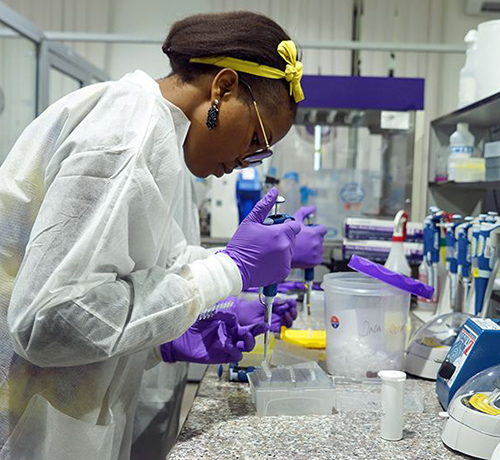Clinical pathology laboratory professionals have long been aware of the potential diagnostic properties related to CRISPR (Clustered Regularly Interspaced Short Palindromic Repeats) technology. Now, new tests using the gene-editing tool show that potential is being realized.
One example involves using CRISPR to detect diseases in Nigeria, where a Lassa fever epidemic has already led to the death of 69 people this year alone. According the journal Nature, this diagnostic test “relies on CRISPR’s ability to hunt down genetic snippets—in this case, RNA from the Lassa virus—that it has been programmed to find. If the approach is successful, it could help to catch a wide range of viral infections early, so that treatments can be more effective and health workers can curb the spread of infection.”
Researchers in Honduras and California are working on similar projects to develop diagnostic tests for dengue fever, Zika, and the strains of human papillomavirus (HPV) that lead to cancer. There’s also a CRISPR-based Ebola test pending in the Democratic Republic of Congo.
These new genetic tests, which may be as simple as at-home pregnancy tests to use, could save many lives throughout the world. They will give medical laboratories new tools for diagnosing disease and guiding therapeutic decisions.
Shift in How Researchers View CRISPR
“We really think of CRISPR fundamentally as a kind of search engine for biology—like Google for biology—rather than [a kind of] word processing tool, although it’s really good at that too,” Trevor Martin, PhD, co-founder and CEO of Mammoth Biosciences, told CRISPR Cuts, a Synthego CRISPR podcast.
Mammoth is a team of PhDs working out of Doudna Lab at UC Berkley, a research laboratory run by Jennifer Doudna, PhD, Professor of Chemistry,
Professor of Biochemistry and Molecular Biology, and Li Ka Shing Chancellor’s Professor in Biomedical and Health.
Martin’s statement represents a shift in how researchers are thinking about CRISPR. At first, CRISPR was seen as a tool for cutting and pasting genetic material. Scientists could tell it to find a target DNA sequence, make a cut, and paste in something different. However, by thinking of the tool as a search engine, CRISPR’s tremendous diagnostic potential becomes apparent.
“This is a very exciting direction for the CRISPR field to go in,” Doudna told Nature.
Martin told CRISPR Cuts that diagnostics is “fundamentally a search problem,” adding, “Now you can program [CRISPR] to find something, and then tell you that result.”
Doudna notes in Technology Networks that, “Mammoth’s technology exemplifies some of the most urgent, impactful, and untapped potential in the CRISPR space.”

Fehintola Ajogbasile (above), a graduate student at the African Centre of Excellence for Genomics of Infectious Diseases in Nigeria, uses a CRISPR diagnostic test to look for Lassa virus in a blood sample. Similar clinical pathology laboratory tests are becoming available in the US as well. (Photo and caption copyright: Nature/Amy Maxmen.)
Investors See Economic Benefits of CRISPR
The potential financial and economic impact of simple-to-use CRISPR-based diagnostic tools is considerable. Technology Networks notes that the diagnostics market is estimated at $45 billion, and that venture capital firms Mayfield, First Trust Mid Cap Core AlphaDEX Fund (NASDAQ:FNX), and 8VC have all invested in Mammoth Biosciences.
Although the diagnostics market is huge, a critical aspect of the Lassa fever diagnostic test the Nigerian researchers are developing is that it will be as accurate as conventional clinical laboratory testing methods, but much simpler and less expensive.
Dhamari Naidoo, a technical officer at the World Health Organization (WHO) told Nature that researchers often fail to think about the fact that new technology must be affordable for use in low-income countries.
About a dozen diagnostic tests for Ebola have been developed, according to Naidoo, but only two have been used recently in the Democratic Republic of Congo, where the virus is resurging, due to economic concerns. To be useful, medical laboratory tests in low-income countries must be affordable to license and distribute, and critically, the manufacturers must identify a market large enough to motivate them to make and distribute such diagnostic tests.
Future Directions for CRISPR and Clinical Pathology
Researchers first discovered what would come to be known as CRISPR in the early 1990s. However, it wasn’t until 2012 – 2013 that scientists used CRISPR and Cas9 for genome editing, a Broad Institute CRISPR timeline notes.
Now, researchers around the world are finding innovative ways to employ the technology of CRISPR to detect disease in some of the most remote, challenging areas where diseases such as Lassa fever, Zika, and dengue fever among others, have devastated the populations, as Dark Daily has previously reported.
What’s next for clinical and pathology laboratories and CRISPR? We’ll let you know.
—Dava Stewart
Related Information:
Faster, Better, Cheaper: The Rise of CRISPR in Disease Detection
Biology’s Google: CRISPR Diagnostics Are Changing Medicine
CRISPR Diagnostics Could Detect Any Disease on a Paper Strip



